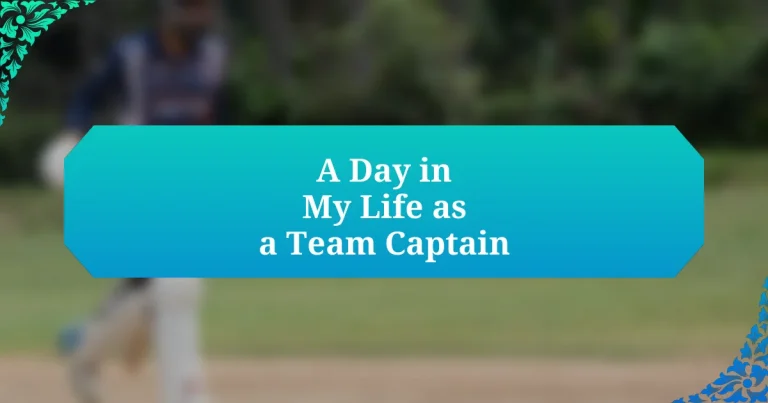Key takeaways:
- The chemistry and emotional connections among teammates greatly enhance performance in cricket.
- Effective leadership is crucial for boosting morale, making strategic decisions, and fostering unity within the team.
- Clear communication, active listening, and well-structured practice sessions are key to improving team dynamics.
- Adapting strategies during matches and maintaining flexibility can significantly impact the outcome of the game.
Author: Emily Thornton
Bio: Emily Thornton is an award-winning author known for her compelling storytelling and richly developed characters. With a background in literature and a passion for exploring the complexities of human relationships, she has penned several best-selling novels that resonate with readers around the globe. Emily’s work has been featured in prominent literary journals, and she is a regular contributor to various writing workshops. When she’s not writing, Emily enjoys hiking in the beautiful landscapes of her hometown and spending time with her rescue dogs. She currently resides in Portland, Oregon, where she continues to create captivating narratives that inspire and entertain.
Understanding cricket team dynamics
In cricket, the dynamics of a team can greatly influence the outcome of the game. I remember a match where our team’s chemistry was palpable; we communicated instinctively, which elevated our performance beyond individual talent. How often do you see a team win solely based on skill? It’s usually a mix of strong relationships and trust among teammates.
Each player brings unique strengths and weaknesses, shaping the overall team balance. I often found myself strategizing around a bowler’s confidence; if they felt supported, their game improved dramatically. Isn’t it fascinating how emotional connections can enhance performance? Understanding these nuances can turn a good team into a great one.
Furthermore, leadership plays a crucial role in fostering a healthy team dynamic. I’ve seen teams falter when leaders don’t embrace diverse perspectives. It’s essential to ask: how can we encourage every player to voice their ideas? By cultivating an inclusive environment, we can unlock the full potential of the team and drive collective success.
Importance of leadership in cricket
Leadership in cricket is vital for steering the team’s performance and morale. I recall a crucial match where my role as captain shone through. In a moment of tension, I chose to back a struggling teammate. That simple act of faith boosted his confidence, and he went on to turn the game around. Isn’t it amazing how a leader’s belief can ignite a player’s potential?
Moreover, effective leadership shapes decision-making on and off the field. I remember a time during a particularly challenging game when I needed to make quick bowling changes. With a clear strategy and calm communication, I inspired trust and quick adaptation among my teammates. When players respect their captain’s decisions, they often perform with greater conviction. How many times have you witnessed a team crumble under poor guidance?
Additionally, a captain must nurture a sense of unity. I’ve often held team meetings where we openly discussed our goals and individual contributions. It created an atmosphere of shared responsibility; every player felt their input mattered. Isn’t that the essence of teamwork? When everyone believes they play a critical role, the team can face any challenge with resilience and determination.
Strategies for effective team communication
Clear and open communication is a cornerstone of effective team strategy. I remember one practice session where we struggled to communicate during drills. We were all over the place, leading to frustration. After that day, I emphasized the importance of calling out plays and supporting each other with feedback. It transformed our practice sessions dramatically. Have you ever noticed how a little clarity can lead to big improvements?
Furthermore, leveraging technology can enhance our communication, especially in the modern game. I often use a messaging app to share strategies or game plans with my teammates. It allows us to stay connected, even off the field, and encourages players to ask questions or share their thoughts. During a tournament, this approach kept everyone on the same page and helped us build chemistry quickly. Isn’t it powerful how a digital tool can bridge gaps and strengthen team dynamics?
Lastly, active listening is essential—it’s not just about talking; it’s about tuning in to what others are saying. I consciously practiced this during team huddles, ensuring that each player had the space to express ideas or concerns. This not only fostered respect but also allowed us to make collaborative decisions. When team members feel heard, it enhances their commitment to the team’s vision. How often do we underestimate the impact of simply listening?
Planning effective practice sessions
Planning effective practice sessions is crucial for a team’s development. I recall a time when we allocated a specific focus for each session, whether it was fielding, batting, or bowling. This clear structure not only kept the sessions organized but also ensured that we could measure our progress in different skills. Isn’t it refreshing to see tangible improvements when everyone knows what to work on?
I’ve discovered that incorporating mix-and-match drills keeps things engaging for everyone. For instance, I often blend skills practice with competitive games, like a mini-tournament among ourselves. This approach lightens the mood and fosters a healthy competitive spirit while still honing our skills. Have you ever thought about how a little competition can bring out the best in players while making practice fun?
Feedback sessions after practices are another strategy I highly value. I remember one evening when we all gathered to discuss what worked and what didn’t. The insights we shared helped shape our next practices significantly. It transformed our dynamics, allowing us to address concerns openly and collectively. Do you find that creating space for feedback enhances your experience as part of a team?
Adapting strategies during matches
In the heat of a match, adapting strategies on the fly is absolutely crucial. I vividly remember a game where our batting order wasn’t performing as planned. With the team struggling to find momentum, I decided to promote a lower-order batsman who had been in fantastic form during practice. That shift changed the game for us; it was a bold move that paid off, and it reinforced the idea that flexibility can be a game-changer.
During another match, the weather turned unexpectedly, impacting the pitch conditions. It was clear that our usual spin-heavy approach wouldn’t work on the damp surface. I quickly gathered my team and adjusted our field placements and bowling styles, opting for seam bowlers who could exploit the conditions better. This adaptability not only surprised our opponents but also demonstrated the importance of being responsive to external factors. Has this ever happened to you, where a sudden change forced you to think on your feet?
As a captain, I also learned that reading the opposition is just as vital. I recall a match where the opposing team had a strong middle-order partnership. I sensed their confidence and decided to rotate our bowlers more frequently to disrupt their rhythm. This tactic created pressure, leading to crucial wickets that turned the game in our favor. It reinforced my belief that strategy isn’t just about pre-planning; it’s about observing and responding in real-time. Have you experienced a moment when your tactical adjustments made a significant difference in a match?
My personal experiences and challenges
Facing the challenges of leadership sometimes feels overwhelming. One particular match stands out where tensions were high after a series of losses. I could sense the anxiety among my teammates, and it weighed on me. I chose to address it head-on; I gathered them in a circle, shared my own fears, and reminded them of our past victories together. This openness fostered trust and reignited our determination, turning our mental state around.
Managing team dynamics also poses its own hurdles. In one game, two players had a disagreement that spilled over onto the field. It distracted not only them but also the entire team, affecting our performance. I took it upon myself to mediate the situation, pulling them aside during the drinks break. After addressing their concerns and encouraging them to refocus on our shared goals, we were able to return to the game revitalized. Have you ever had to step in to resolve conflicts within your team?
Lastly, balancing my role as a captain while also contributing as a player adds another layer of complexity. In a tightly contested match, I found myself overwhelmed, torn between leading from the front and making tactical decisions. There was a moment where I misjudged my own batting position, losing my wicket earlier than anticipated. It was a tough lesson, but I realized that sometimes I need to prioritize my own performance to set an example. Have you faced a situation where your dual responsibilities impacted your game?





